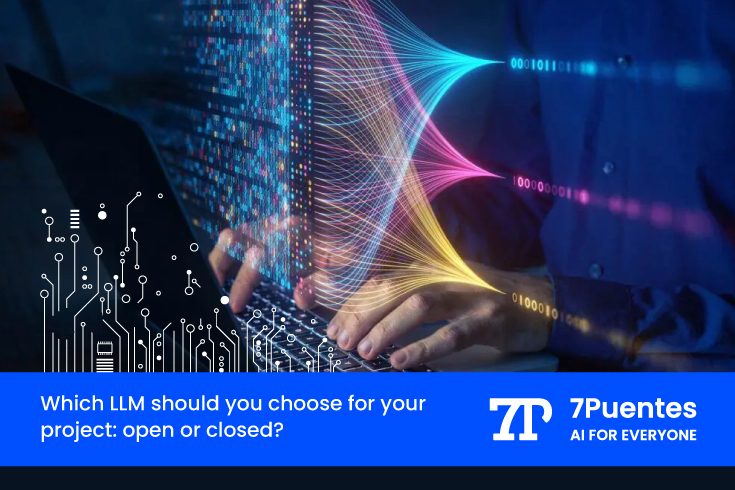Introduction to Open and Closed LLM
Large Language Models (LLMs) represent a very significant advance in AI and are more accurate than traditional machine learning algorithms. Their use in business has become highly desirable. However, due to the complexity of training models with data from each company and improving both their functionality and effectiveness, the dilemma arises as to whether it is better to use open source models or proprietary software models. Find out more in this post!
Large Language Models (LLM) are a category of basic models that are trained on immense amounts of data, making them capable of understanding and generating natural language and other types of content to perform a wide variety of tasks: from generating meaningful responses to providing valuable information to the business, processing huge amounts of text.
Their ability to generate responses similar to human dialogue or other natural language input has popularised AI and brought generative AI to the forefront of public interest. So much so, that organisations are looking to invest resources and skills to apply AI to a wide range of business functions and use cases.
In this way, LLMs represent a significant advance in NLP and AI, and are easily accessible to the public through interfaces such as Open AI’s GPT chat, which is supported by Microsoft. Other examples include Meta’s Llama models and Google’s Bi-directional Encoder Representations of Transformers (BERT/RoBERTa) and PaLM models. IBM, for its part, has also recently launched its Granite series of models in Watsonx.
Although Open AI has the most advanced LLM due to its growth and evolution, it should be noted that these models started as open source as part of the academic culture: groups of scientists who, although funded by companies, shared this spirit of collaboration and open knowledge.
Towards informed decision making
Today, in 2024, business leaders are asking themselves the key question about LLMs: should I use an open or closed model? The answer is not simple and involves a number of nuances (even in 2025, this answer will probably need to be updated).
First of all, customisation, adaptation and fine-tuning are inherent to the model in which LLMs are included, and it would seem that the open model would win over the closed model, but there is the concept of zero-shot learning, which represents a previous step.
This is a machine learning scenario in which an AI model is trained to generalise in semantic categories as quickly as possible, so that it can recognise and categorise objects or concepts without having seen any examples of those categories or concepts before.
In turn, the LLM training process requires several successive steps:
- Data collection: a diverse set of textual data is collected from different origins and sources.
- Preprocessing: The collected textual data is cleaned and standardised.
- Tokenisation: The pre-processed text is broken down into smaller units called «tokens».
- Architecture selection: The appropriate deep learning architecture is selected, such as a transformer model.
- Training: The actual training process by which the model learns the data.
- Results improvement: The model is optimized by introducing fine tuning.
- Evaluation: The results and accuracy of the model are evaluated.
- Deployment: The model is deployed in a working system for use.
When we talk about open LLM, we are talking about the weight of the neural network, where you could download all the data into a set of files. This phenomenon is often called a «training snapshot».
Let’s imagine this example: we have a pendrive connected to a coffee machine and we start to introduce objects into a multiprocessor, usually food and liquids, that’s the data; the machine starts to liquefy them and when we’ve finished entering all the data, we take out the pendrive and see what’s inside: this is the key because it would be the internal configuration of this neural network, the internal state.
In the end, it is about the parameters of the model. If we say that Llama (Meta software) can come in “n billion parameters”, the pendrive is heavier or lighter because it has more or less data. In the case of a neural network, we are talking about the weights of the files, in addition to the topology of the network, which has different layers.
The difference is that with an open model we can understand how this dynamic works, we can see the values and how they have been processed, whereas proprietary software like ChatGPT is a real black box: even if we use it with our own data, we don’t know how it works, even if we can guess what’s in the back end because Open AI decides to show us some bits of code.
While it’s true that closed models have become popular because of their ability to proliferate, it’s worth looking at the Massive Multitask Language Understanding (MMLU) benchmark, which helps us compare different LLM models and evaluate their performance.
In this respect, the growth of open source models and AI startups stands out, from the Cohere software (which attracts customers such as Oracle and Notion Labs) to Qwen (which has a very high performance to compete with any commercial model), as some emerging examples.
At the same time, it is recommended that you visit the Hugging Face Model Leaderboard regularly to see some of these examples and compare them with proprietary software.
Factors involved in choosing an open or closed model
Among the main factors to consider when choosing a model type for your business project, we highlight
- 1) Speed of prototyping: Today, it is clear that the limited cost and speed of using an Open AI or Copilot API is a good option to build a very fast proof of concept. At the same time, there are services like together.ai where we can test an LLM in a simple way. The key is to assess the feasibility of the project. For example, if we are a prepaid medical company, we might be interested in knowing if a medical diagnosis can be made with an Open AI LLM, and this test is usually done in a week. Now, if we know in advance that the LLM already works for our project and that it is viable, then we do not need to build a prototype and we could use open source directly. Instead, the general rule would be to use Open AI to test the feasibility of the project.
- 2) Internal skills (upskilling): The internal upskilling that the organization has, especially in terms of technical and business capabilities, is key to determining what type of LLM to use. If we have a very experienced AI team in the organization, it would be a good idea to start with open source because we know a lot about the technologies. Let’s say we have a multimodal project and we want to give the last LLAMA from Meta a chance. We are talking about a very large GPU infrastructure, not a small architecture, so we need people who know all the technical and operational aspects of this topic.
- 3) Cost: Clearly, there is fierce competition in the enterprise and AI product space to drive costs down to infinity, especially if we’re thinking about processing a large amount of data. Remember that Open AI charges us per token (words, character sets or combinations of words and punctuation that LLMs use to break down the text coherently). As the texts are usually long and the images consume a lot of tokens, the process is usually very expensive. Today, there are many service options and the cost for a large organization and multiple applications is still uncertain. A 160-gig NVDIA H100 costs $56,000 for three years, but if we extrapolate this to a cluster, we are talking about tens of millions of dollars. Alternatively, we can mention the case of a company called Nebius, whose business model is to service open source models by providing us with the infrastructure to host the model. The bottom line is that we have to look at each use case and adapt accordingly. But the infrastructure to manage a large open source model is expensive, whereas Open AI will continue to reduce its cost as there are more customers. If there are no people to manage the whole infrastructure, it is probably better to use proprietary software.
- 4) Security: The first point is having control and autonomy over what happens, and the second is who is responsible (liable) if a serious problem occurs. In this sense, the open source model is more secure if we have the right people managing it. On the other hand, in the corporate world of large companies, sometimes the decision is made to outsource security to companies like Microsoft, which has partnered with Open AI to manage the security of the models and already has a history of testing on the subject and can be held responsible if an error occurs. In the case of open source, this will certainly happen as in the case of Redhat, Apache, MySQL or Linux, which had partner companies that provided support for these models. The evolution of open source in terms of bug fixes will be better because in the corporate case the processes to fix bugs are sometimes long. But if we use closed software, we have more version restrictions, for security and bug fixing issues, a closed model has a version ceiling or versions that cannot yet be implemented in certain corporate projects.
- 5) Specialisation: Specialization clearly favors open source. The rules that applied to open source before LLM still apply. It is a question of looking back and seeing the benefits that its specificity can have in sectors such as health, the public sector and government. In this sense, «open» does not mean «free». It refers to open source, not free software. There are details in the Llama licenses that make it impossible to use. And there may be projects that use proprietary software at one stage and open source at another. An agent can internally orchestrate these interactions with LLMs in the organization, such as a proof of concept using Open AI and later using an open source. Another example is the embedding of databases that are proprietary, but which we later use with an open source model.
7Puentes: Your expert advice in LLM
If you are an executive in your company and you are still not sure which large language model is the most appropriate for your project, at 7Puentes we can advise you at all levels: from knowing your starting point in AI, what resources and skills you currently have, to understanding the requirements and limitations of your project, when to use each model and what would be the best strategic decision in LLM.
We have the right expertise in AI and Machine Learning to guide you through the entire process, ensuring you get the best results.


